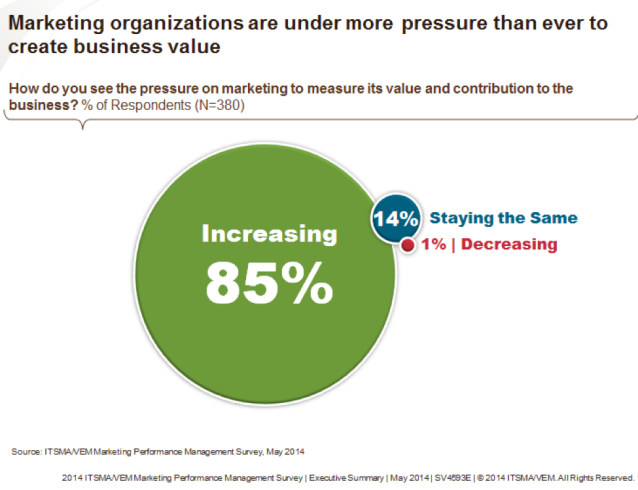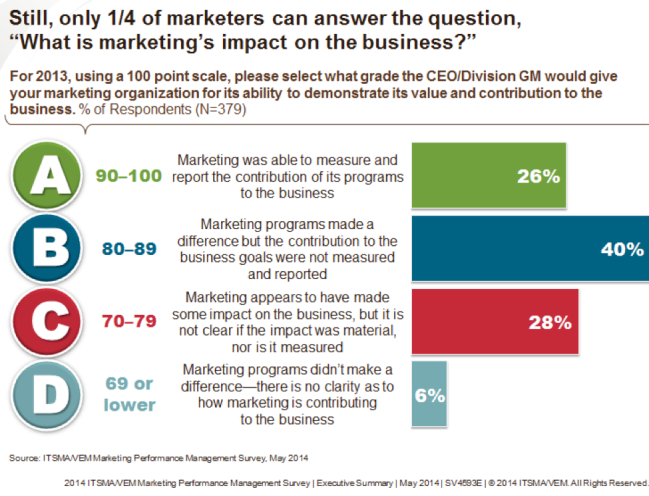CEO
Best-in-Class Marketers Prove They Create Value
In 2000, the Advertising Research Foundation probably didn’t realize that their report about marketing’s ability, or lack thereof, to measure its value and contribution would initiate numerous studies, conferences, and products on the topic. This year’s joint VEM/ITSMA Marketing Performance Management Survey* , which looks at how marketers and C level executives would rate marketing’s value, revealed that 85 percent of the nearly 400 study participants are seeing increased pressure for marketers to measure marketing’s value and contribution.
A key component of the annual study looks at the comparison of the number of marketers earning an ‘A’ grade from the C-Suite for their ability to impact the business and measure their value with their counterparts who are falling short. The grades remained relatively consistent with prior years, with only a quarter of the marketers earning an ‘A’ for their ability to measure and report the contribution of marketing’s programs to the business.
By now one would think this journey would be nearing completion, but there appears to still be plenty to learn. Over the years, the study has revealed that ‘A’ marketers exhibit a number of differences from their colleagues–they are better at alignment, accountability, analytics, automation, assessment, and alliances. The investments in these capabilities and how they approach the work of marketing has enabled them to serve as value creators for their organizations. On the other hand, the marketers in the “middle of the pack” focus more on enabling sales, and the laggards operate primarily as campaign or program producers. In this day and age, with all the technology that marketers have at their fingertips, it begs the question “Why can’t ‘B’ and ‘C’ marketers get close to C-level executives and show their value?”
Become a Value Generator
Marketing organizations that create value are proactive. The ‘A’ marketers hold themselves accountable for contributing to business outcomes even if senior leadership doesn’t. They believe it is their responsibility to identify, investigate, evaluate, recommend, and prioritize market and customer opportunities. These marketers implement continuous change to maximize the organization’s success, and enable it to stay abreast or ahead of market, customer, and competitor moves. ‘B’ and ‘C’ marketers don’t seem to do that, don’t ask the right questions, or don’t know how to show their value.
Make Marketing Performance Management a Priority
According to the data, organizations that are performing well when it comes to customer value and business growth, are those where the marketers excel at performance management. ‘A’ marketers prioritize performance management, establish a clear roadmap for performance improvement, and focus on aligning marketing to the business not just sales. They have regular two-way dialogue with senior leadership and are motivated to select and report on the metrics that matter most.
Here are three qualities of this elite group that any marketing organization can emulate:
- Be a business person first, a marketer second
- Provide customer and market insight to inform business strategy, in addition to enabling sales
- Tap experts to hone skills and improve capabilities
Join the conversation with VisionEdge Marketing and ITSMA in our webinar, The Link Between Performance Management and Value Creation, Tuesday, June 17th, from 10:00-11:00am CST.
*VEM has been conducting the survey for 13 years. ITSMA has co-sponsored the survey for the past three years.
Five Proven Practices for Customer Experience Mapping
Customers are the most important part of any business, and keeping them happy should be at the top of your list of priorities. If your organization is among those that have created customer experience maps, kudos to you and your team! If not, and this is an itch you want to scratch, read on for five (5) tips to help you undertake this important initiative.
Before we offer advice for mapping the customer experience, it might be useful to make sure we’re all on the same page in terms of what we mean by customer experience. At VisionEdge Marketing, when we refer to customer experience we mean the points of interaction between the customer and an organization. These touch points include, but are not limited to, interactions associated with pricing, purchasing, servicing, payment/billing, support, and delivery of your organizations offerings (goods and/or services).
How customers evaluate their experience is based on their perception of the actual performance of the organization at that point of interaction compared to the customer’s expectation. In 2005, James Allen from the Harvard Business School revealed that while 80% of businesses state that they offer a great customer experience, only about 8% of customers feel similarly about their experience. Understanding this perception versus the expectation, and the gaps across all experiences, enables you to create customer experience performance targets and key performance indicators.
Customer experience mapping is a vehicle for capturing the perceptions versus the expectations across all points of interaction, ideally for each customer segment and/or persona. The mapping process should enable you to develop processes and skills designed to deliver an experience that sets your organization apart in the eyes of your customers, hopefully resulting in customer loyalty and becoming advocates for your goods/services.
Many organizations often mistake creating a process map with creating a customer experience map. While similar, their focus is quite different. A process map describes your company’s internal processes, functions, and activities and generally uses the company’s internal language and jargon. A customer experience map describes the customer experience in, and only in, the customer’s language. What makes customer experience mapping challenging is the fact that the customer experience is typically quite complex, because it cuts across divisions, departments, and functions.
Here are five key steps to help you create your customer experience map:
1. Start with the universal touch points that can be applied across all your customers (you can create more specific experience maps as time goes on)
2. Make a list of all the touch points. For each touch point write a description, method of interaction, and customer expectation. We have found that this step is best accomplished by:
- Involving as many people as necessary, including members of your customer advisory boards, to identify all touch points
- Holding working sessions and conducting interviews to capture and incorporate the expected and actual emotional, experiential, and functional experiences for each touch point
3. Document your learnings and produce a visual illustration (map)
4. Use the map to identify areas working well and those that need improvement. Focus on those areas that are known as “moments of truth,” those crucial interactions that determine whether the customer becomes or remains loyal
5. Build a plan to address James Allen’s “Three D’s,” which he believes enables organizations to offer an exceptional customer experience:
- Design the correct incentive for the correctly identified consumer, offered in an enticing environment.
- Deliver the proposed experience by focusing the entire team across various functions.
- Develop consistency in execution.
Sometimes organizations need help with this, which is why there are experts out there! Don’t be afraid to ask for help–this is an area you do not want to ignore.
Free Benchmarking–Does Your Marketing Measure Up?
Here’s something we know after conducting the marketing performance measurement and management study since 2001: Best-in-Class marketers are relentless when it comes to continuous improvement. How do they know how they stack up? They regularly audit and benchmark. We know this can be expensive—even a small benchmarking study for marketing typically takes at least $20,000. With marketing budgets still feeling the crunch, it makes sense to be a bit more creative when it comes to benchmarking. And that’s where our annual marketing performance study comes in!
There are plenty of studies out there, and only you can decide which ones are worth your time. As a marketer you could probably complete a study every day, but if you are feeling the pressure to prove the value of your marketing, then this survey is for you. With 13 years under its belt and participation from marketing professionals and executives from around the world, in every industry and of all size organizations, we are able to provide a solid view into what Best-in-Class marketers do better and differently when it comes to measuring marketing’s contribution and value.
Given how hard you’re working every day, it’s frustrating when budgets are slashed and programs are terminated. You know Marketing is highly valuable to the business, but can you prove it? If you can, you may be among the ranks of the Best-in-Class—those marketers who have made marketing relevant to the C-Suite! If you can’t, it’s probably time to make some changes.
Find out how your organization stacks up against the Best-in-Class. Give 15 minutes of your time to participate in the 13th Annual MPM Survey and save the benchmarking dollars.
What does the survey benchmark? The focus of the survey is Marketing Alignment, Accountability, Analytics, Operations, and Performance Management capabilities. Complete the survey, share the link with your marketing colleagues and leadership team, and use the survey and the upcoming results to spark internal dialogue on the state of your marketing!
You can access the survey by following this link: https://www.surveymonkey.com/s/2014MPM_VEM
Weaving Contextual Data into Models
Many companies are developing opportunity scoring models which essentially assign a predetermined numerical score to specific behaviors or statuses within a database. The purpose of opportunity scoring is help sales people know which opportunities are sales ready and worthy, and therefore take priority. Often variables such as title, company, and industry, serve as the basis for the scoring model. However, behaviors can be used too, such as the completion of a contact form, visiting a particular page on the website, participating or viewing a demo, etc. Contextual data adds another dimension to the model by weaving in predisposition information that reflects content, timing and frequency-for example what products they currently use, the last time they purchased, their complete buying history, the types of keywords they used in their search, etc.
Keep in mind, timing is everything. To be effective, contextual data must be delivered to the right person, at the right time, within an actionable context. For example, the date of a key customer’s contract renewal is posted in your CRM system all year long, but that doesn’t mean you’ll remember or even see it. Think how much more useful that data becomes when your system automatically alerts you to the fact that it’s the customer’s renewal date. Sending email messages about renewals too early just creates noise at best and at worst suggests you don’t know their renewal date. Customers are more likely to respond to call to action when it is in context of their workflow. Communication that is contextual is more personal and as a result feels more authentic, shows value, and leads customers want to act. As a result, you can reduce the cost of customer acquisition and the cost of sales.
The end goal of contextual data is to connect with the buyer when they are most predisposed to buy. As a result, you can use contextual data to help build propensity to purchase models, for prioritizing opportunities to support opportunity scoring, to develop more personalized messages, and select the best mix of channels.
This same concept of contextual data can be used to build propensity to purchase models. By identifying the winning experiences associated with a particular segment, you can use this information to craft more relevant messages to similar targets to increase uptake.
Personalization is a compelling and challenging proposition. It’s a moving target and therefore requires a test and learn approach. By adding contextual data into the process you can make your personalization efforts more effective and more relevant.


